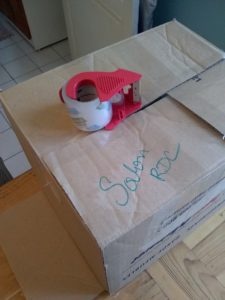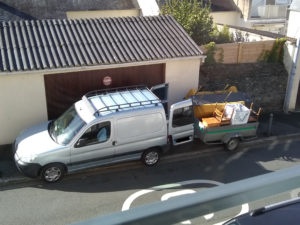5 Rules for an Easy Move
I’m a drifter. I’ve lived in so many apartments I can’t remember them all. Below are 5 rules for an easy move that I’ve distilled to make moving a breeze.
1. Don’t have a lot of things
This is the most important and probably the most difficult rule to follow. It requires constant discipline, and maybe can only be truly achieved by that class of people who are fortunate to have a not-so-distant home-base (Mom and Dad’s – ahem.)
If you’re going to live in an apartment or room in a shared house for less than a year – is it really necessary that you lug all of your books, clothing, and furniture with you?
Speaking for myself I’d say no.
Yes, some books are important to have around – especially if you find comfort in re-reading them. You should always have adequate clothing for the season (as Henry Crans says: “There’s no bad weather, only bad clothing.”) but does that mean you need arctic socks for a summer sojourn?
You can probably cut out the furniture, especially anything bulky. Will your apartment already be furnished?
Do you really need that extra-soft mattress?
Do you need your own massive, real-oak desk?
All this depends on the city you’ll be moving to of course. But smaller, lighter versions of the furniture you most need is almost always findable; especially if you’re moving into a college town. All those people moving in are taking the place of a whole bunch of people moving out; people who are in many cases desperate to get rid of their stuff.
Remember, if you bring it with you, you have to either a.) bring it back with you, or b.) get rid of it. Why add extra stress to an already difficult day?
Now for an easier rule to follow:
2. Have quality boxes and containers

You don’t want to mess around with a bunch of mismatched, dirty boxes when you’re aiming for speed and efficiency.
Where to get good boxes?
That depends on your expendable income. Ideally, you’d be able to buy some quality folding boxes – the sort used in offices for file storage. These are ideal because they are: uniform in size, they have lids, they are stackable, reusable, and they can be stored easily for your next move.
These can usually be found at office supply stores. Or perhaps you can ask to borrow some at work? You can also buy quality boxes at the truck rental company – rule 3.
For the more economic movers – I’ve two good suggestions:
Ask at your local grocery store. They’ve almost always a surplus of boxes to get rid of and won’t mind your grabbing a few. Remember this isn’t their primary activity, you’ll want to be polite and flexible to fit their schedule and availability.
Ask at your local liquor store. This isn’t my preferred place to get boxes, often they’re too tall and too small, but you never know; they might work.
To make sure you haven’t forgotten anything – I’ve got a strange trick. Find a chair or some other object to stand on. Set it in the middle of the room and climb onto it. Then look around the room from your new vantage point.
It sounds silly, but I guarantee you will see the room more objectively since you won’t be so used to this perspective. From here it is much harder for your eyes to slip over items that you’re normally habituated to.
Did you get your pictures, paintings, window coverings?
Kitchen Goods
This merits its own category. Think about it; look into your kitchen and see all the oddly shaped appliances, cooking ware, foods, boxes, and containers. These items can be covered in oil and coffee stains. Sometimes the items will need refrigeration. Or maybe they’re fragile.
You’ll want to set enough time aside to clean anything dirty (and allow it time to dry.)
If your stay’s been short maybe you haven’t had enough time to accumulate too many things yet.
In that case, a plastic tub is what I’ve found most useful.
The idea comes from the ‘camp kitchen’ my family used to drag along with us on our outings to the Catskills. It had every kind of condiment, utensil, and nic-nac you could think of. Having one big tub with all the kitchen gear allowed us to quickly move in and become operational, as well as to pack up at the end of our stay without too much stress. As a bonus, we always knew where all the kitchen goods were.
Napkins and towels can be used for cushioning fragile objects. Or for keeping together multi-piece sets (silverware.)
Knives can be sheathed in a folded piece of cardboard secured by tape.
For plates and bowls, you’ll probably need to reinforce the bottoms of your boxes. You can do this by cutting a piece of cardboard and placing it on the bottom of the box. This should help distribute the weight more equally.
Speaking of re-enforcement, that reminds me of two other essential items:
Tape and Markers

Maybe you’ve got an old sharpie or two lying around, or some old packing tape. If not, please go buy some. This will make your move infinitely easier.
If you’re super anal (or if you have a lot of rooms with different items to keep track of) write the contents of each box on three sides of the box. This will enable you to easily keep track of your possessions while stacking boxes and during the loading/unloading process. If your boxes have already been used for a move – cross off whatever was written before.
For example:
Kitchen – plates; Living room – junk drawer; Bathroom – cleaning products.
A good role or two of tape is necessary as well. Especially for the economic mover. Those boxes in poor shape are going to need a bit of extra love and attention around the corners. If you’re doubtful about the bottom, why chance it? Re-enforce with a square of cardboard on the inside as well as some strips of tape on the outside.
3. Get access to an appropriate vehicle

I’ve often heard the joke when someone buys a new truck that they’ll be real popular around moving day. Though it isn’t very funny it is certainly correct – on moving day you’ll need a vehicle with big, empty floor space. Especially if you ignored rule 1 and accumulated heavy and bulky furniture.
Yes, maybe you’ve got a friend with a pick-up truck that you can lasso into helping you move, but (s)he probably won’t appreciate it.
If your move is significant the best option is to bite the bullet and rent a real moving truck. Even if you can’t drive, I’m sure you have a friend who can – and this is almost always better than using the dirty bed of someone else’s pick-up.
A note of caution! – If you’re going into or out of a college-town don’t just assume a rental vehicle will be available when you need one; everyone else thinks the same thing. Usually, there are a ton of other people who move in or out on the same few weekends before or after the semester. You’ll want to reserve a vehicle in advance.
There’s nothing worse than showing up on the last day of your lease to learn you’ll have to wait a few days for a truck to be available.
4. Ask the help of friends or family, or hire a team
Where I’m from it’s pretty typical to ask your friends or family members to help you with a move. But it’s not usually anyone’s favorite weekend activity.
The least you can do is offer them a high-energy meal (or several if the move drags on.)
Pizza, in a word.
What’s even fairer is to offer real compensation for their time and efforts.
Everyone’s budget is different of course, but it seems proper that if you’re going to ask your friends to work for you, you should show them your appreciation with some monetary compensation.
Additionally, you should be respectful of your friend’s time and seek to maximize it as much as possible.
I have a horror story of a friend and co-worker of mine who needed help moving his apartment and a very impressive book collection the distance of several miles.
Only several miles – thank God!
He asked me to drive the truck he’d rented as well as to help load and unload his possessions.
This friend however had not packed his books into boxes beforehand. So this move included boxing thousands of books in addition to the actual move. Needless to say, this significantly increased the time required.
My friend was respectful about compensation and meals nonetheless.
Still, I will never look at personal book collections the same way again. I have also been extremely careful not to acquire too many books in my personal life – a practice I’ll be happy to adjust once my partner and I find a permanent housing arrangement.
For the more well-heeled, perhaps hiring a team will be a better approach to finding helping hands. In most cities, you can find professional moving companies – with the added benefit that they come with their own vehicles and materials.
For the more modest, there’s always Craigslist. Make a post for a couple of movers (outline the hours and the rate) and you should have help in no time.
5. Time/Materials for a proper clean
Now that all your possessions are either in the rental vehicle or in your new apartment you’ll want to thoroughly clean your former dwelling. Leave a broom, mop, vacuum cleaner, trash bags, paper towels, some sponges, and cleaning products accessible.
I’d usually start with the most intimidating rooms first just for the morale boost once those are finished. For me, that’s the bathroom and kitchen (particularly the fridge.)
Use the trash bags for any leftover foods or junk you find lying around as well as the used paper towels and trash.
Don’t forget to take pictures of the apartment at the end! Especially if you’re hoping to get your security deposit back. I’ve successfully argued for my security deposit when I showed that the common areas, as well as my individual room, were spotless; even though the rooms of my former house-mates were horrendous.